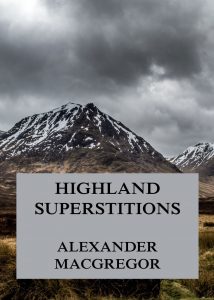Highland Superstitions – Alexander Macgregor
This is Reverend Alexander MacGregor’s excellent work on the superstitions in the British Highlands, containing chapters about general superstitions, druidism, fairies, witchcraft, second-sight, smaller superstitions, hallowe’en, sacred wells and lochs …
Format: Paperback.
Highland Superstitions.
ISBN: 9783849673567.
Available at amazon.com and other venues.
Culture of the Highlands (from wikipedia.com)
Between the 15th century and the 20th century, the area differed from most of the Lowlands in terms of language. In Scottish Gaelic, the region is known as the Gàidhealtachd, because it was traditionally the Gaelic-speaking part of Scotland, although the language is now largely confined to the Outer Hebrides. The terms are sometimes used interchangeably but have different meanings in their respective languages. Scottish English (in its Highland form) is the predominant language of the area today, though Highland English has been influenced by Gaelic speech to a significant extent. Historically, the “Highland line” distinguished the two Scottish cultures. While the Highland line broadly followed the geography of the Grampians in the south, it continued in the north, cutting off the north-eastern areas, that is Caithness, Orkney and Shetland, from the more Gaelic Highlands and Hebrides.
In the aftermath of the Jacobite risings, the British government enacted a series of laws to try to speed up the destruction of the clan system, including bans on the bearing of arms and the wearing of tartan, and limitations on the activities of the Scottish Episcopal Church. Most of this legislation was repealed by the end of the 18th century as the Jacobite threat subsided. There was soon a rehabilitation of Highland culture. Tartan was adopted for Highland regiments in the British Army, which poor Highlanders joined in large numbers in the era of the Revolutionary and Napoleonic Wars (1790–1815). Tartan had largely been abandoned by the ordinary people of the region, but in the 1820s, tartan and the kilt were adopted by members of the social elite, not just in Scotland, but across Europe. The international craze for tartan, and for idealising a romanticised Highlands, was set off by the Ossian cycle, and further popularised by the works of Walter Scott. His “staging” of the visit of King George IV to Scotland in 1822 and the king’s wearing of tartan resulted in a massive upsurge in demand for kilts and tartans that could not be met by the Scottish woollen industry. Individual clan tartans were largely designated in this period and they became a major symbol of Scottish identity. This “Highlandism”, by which all of Scotland was identified with the culture of the Highlands, was cemented by Queen Victoria’s interest in the country, her adoption of Balmoral as a major royal retreat, and her interest in “tartenry”.[
(The text of the last section was taken from a Wikipedia entry and is available under the the Creative Commons Attribution-ShareAlike License.)
Publisher’s Note: This book is printed and distributed by Createspace a DBA of On-Demand Publishing LLC and is typically not available anywhere else than in stores owned and operated by Amazon or Createspace.

